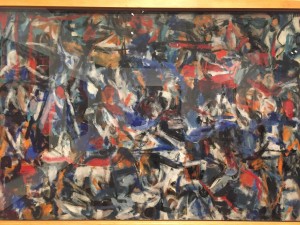The Art Of Transformation
 What’s the difference between an art and a craft?
What’s the difference between an art and a craft?
A traditional definition focuses on differences in expectations and outcomes. With a craft, we know precisely what the outcome will be, even before we start. We have a set of instructions and, if followed faithfully, the outcome is guaranteed.
By contrast, an artist doesn’t know what the outcome will be. Creating an artwork involves exploration, doubt, questioning, trial-and-error, and no small amount of anxiety. An artist explores the unknown and aims to give us new insights. A good artwork may not be beautiful in a classic sense, but it is always imaginative. A craftsman, on the other hand, creates the expected and delivers beauty and pleasure through execution more than imagination.
I thought of these distinctions the other day when I toured a major new exhibition, Women of Abstract Expressionism*, at the Denver Art Museum. The exhibition highlights a dozen leaders of the abstract expressionist movement and their work from roughly 1945 to 1960. Here’s how two of the artists describe the creative process:
- Grace Hartigan: “Eventually, the painting tells you what it wants to be.”
- Jay DeFeo: “When I start, I don’t know what’s going to happen. When you’re dancing, you don’t stop to think: now I’ll take a step … you allow it to flow.”
It occurs to me that the distinction between art and craft also applies to organizational development. Change management is a craft. Organizational transformation is an art.
We often invoke change management when we begin a concise and well-delineated project. We understand the boundaries and the players. We move through well-defined phases that we can measure objectively. We expect changes to occur between people – perhaps with new reporting structures and alignments. Change management is not easy to master but it seems to me that it is a craft. We often celebrate the end result. We can do that precisely because it is a craft – we know when the process ends.
Organizational transformation is much more like an art. When we seek to transform an organization’s culture, we have only a fuzzy idea of where we’re going. Milestones exist but they’re not well defined. Transformation requires changes within people rather than only between people. We can’t see those changes; nor can we measure them. If we try to measure the unmeasurable, we’ll go off course. Like any other art, transformation involves exploration, doubt, questioning, trial-and-error, and no small amount of anxiety. Paraphrasing Grace Hartigan, “Eventually, the organization tells you what it wants to be.” The secret to success is listening, not measuring.
I sometimes ask my artist friends how they know when a piece they’re working on is finished. None of them has very good answers. Some say they “just know”. Others say that they just get tired of it. Others say that it’s never finished. Whenever they see it again, they’re tempted to make “just a few minor changes.”
It occurs to me that I’ve never been to a party to celebrate an organizational transformation. Perhaps it’s because we just don’t know when the transformation is finished. It’s an art not a craft.
*The Women of Abstract Expressionism exhibit is both superb and unexpected. The paintings are exciting and energetic. The painters are almost anonymous. This is the first major exhibition – anywhere in the world — of the women who energized the abstract expressionist movement. That it happened in my hometown makes me more than just a little bit proud. You can see it – and should see it — until September 25th.
The painting illustrating this article is Grace Hartigan’s The King Is Dead, from 1960.
Filtering Water In The Information Desert

It’s a desert out there.
In organizations, large transformation efforts create information deserts. Traditional sources of information dry up. We search for new sources but they’re few and far between. When we do find them, we can’t be sure if the information is tainted or pure. Should we consume it or not?
The lack of information creates additional stress. We know we’re going on a “journey” but we don’t know where. We don’t even know how we’ll know when we get there. Perhaps we’ll never get there. Perhaps we’ll just continue transforming.
We also know that there will be some winners and losers in the process. Some people will get plum assignments; others will be relegated to minor roles. It’s not always clear who will make these decisions or how they will be made. So we don’t know how to behave to improve our chances of success.
We also fear that we’ll lose something. We know what we have today. While it may not be all we want, just knowing what we have brings some degree of comfort. As the organization morphs, we don’t know what we’ll have tomorrow. We could be worse off. Our loss aversion bias makes the possibility of loss seem more likely – and more painful – than the possibility of gain.
When we’re in a real desert, we want to find water. Indeed, we want to find good water. Drinking bad water could be worse than drinking no water at all. So we carry water filtration systems. When we find water, we can purify it and ensure that it will help us rather than harm us.
Similarly, in an information desert, we want to find good, trustworthy sources of information. Since traditional sources of information have dried up, we need to find new sources. But how can we tell if the new sources are trustworthy? Perhaps they’re tainted with rumor and conjecture. Perhaps consuming the information will do us more harm than good.
It’s not easy to create accurate and effective information for a transforming organization. But there are some good filters that can help employees distinguish good information from bad. The simplest one I’ve found is called the triple filter. Some writers say that Socrates created the filters. Others claim Arab philosophers developed them. Regardless of the source, it’s a good communication technique to keep in mind.
According to legend, when someone offered Socrates information – especially information that might be based on conjecture or rumor, he asked three sets of questions:
- Is it true? How do we know? How can we verify it? What’s the source? What’s the evidence?
- Is it good? This is especially important if the information is about a person. Does it portray the person in a good light? Is it kind? Does it assume positive intent?
- Is it useful? Is the information useful to me, the recipient? Can I use it to accomplish something positive?
The process is analogous to deciding what evidence is admissible in court. If the information didn’t pass all three tests, Socrates simply refused to hear it.
I think of these questions as three steps in a linked process. If the information can’t pass the first test – truth — there’s not much point in asking the other two questions. If the information is verifiably true, then it’s useful to continue the process. If the information passes all three tests, then it’s admissible and should be considered in decision making.
Organizations in transition are under a great deal of stress. Bad information only increases the pressure. The triple filter doesn’t make the desert bloom but it helps employees find oases of trust and certitude in a difficult and demanding environment.